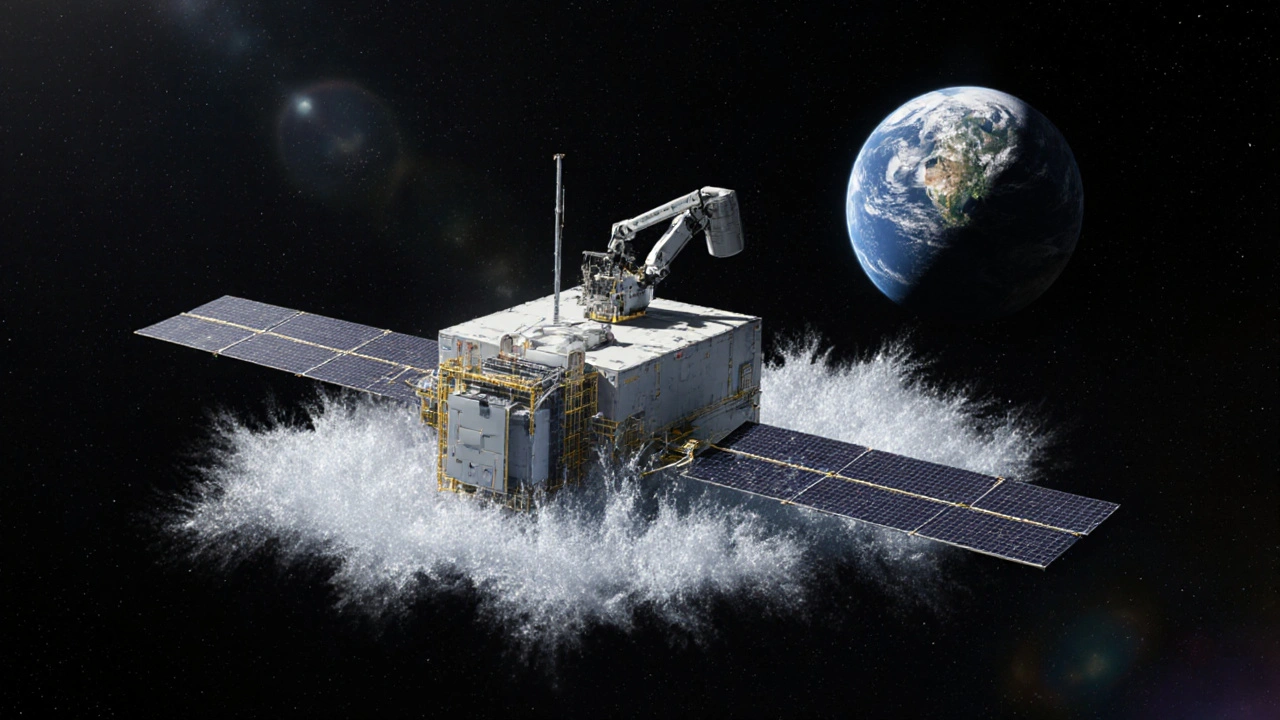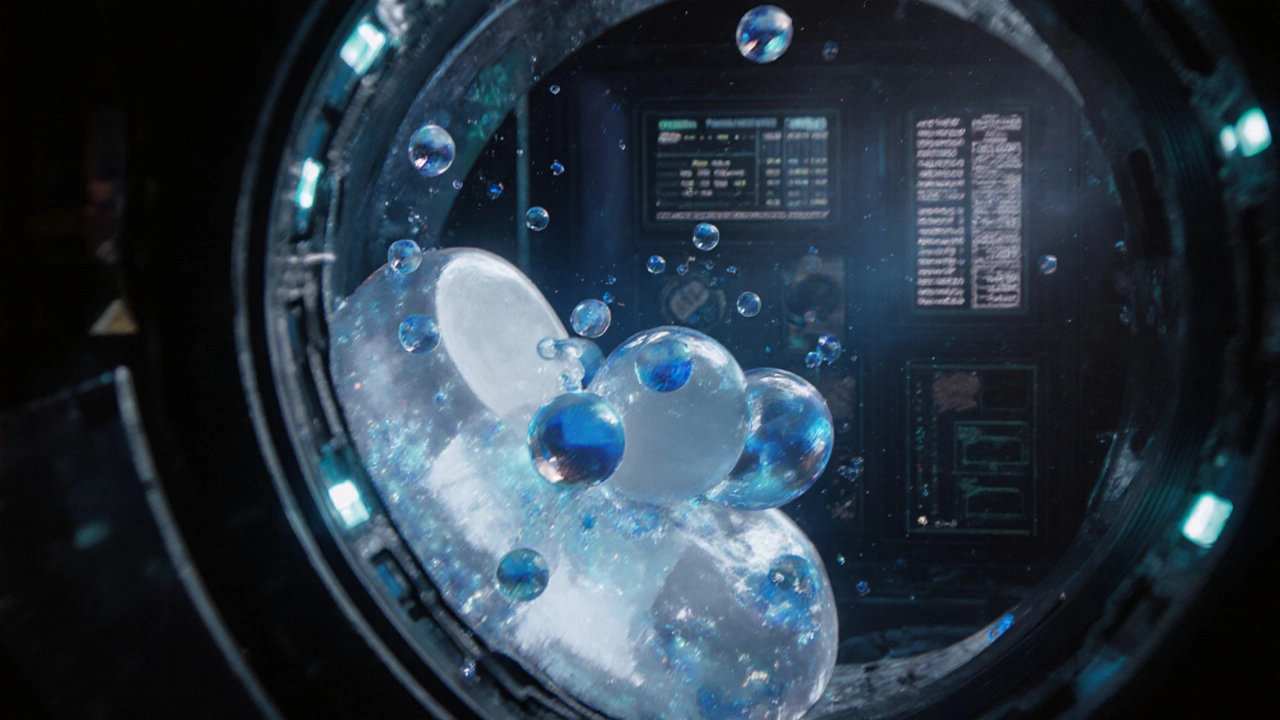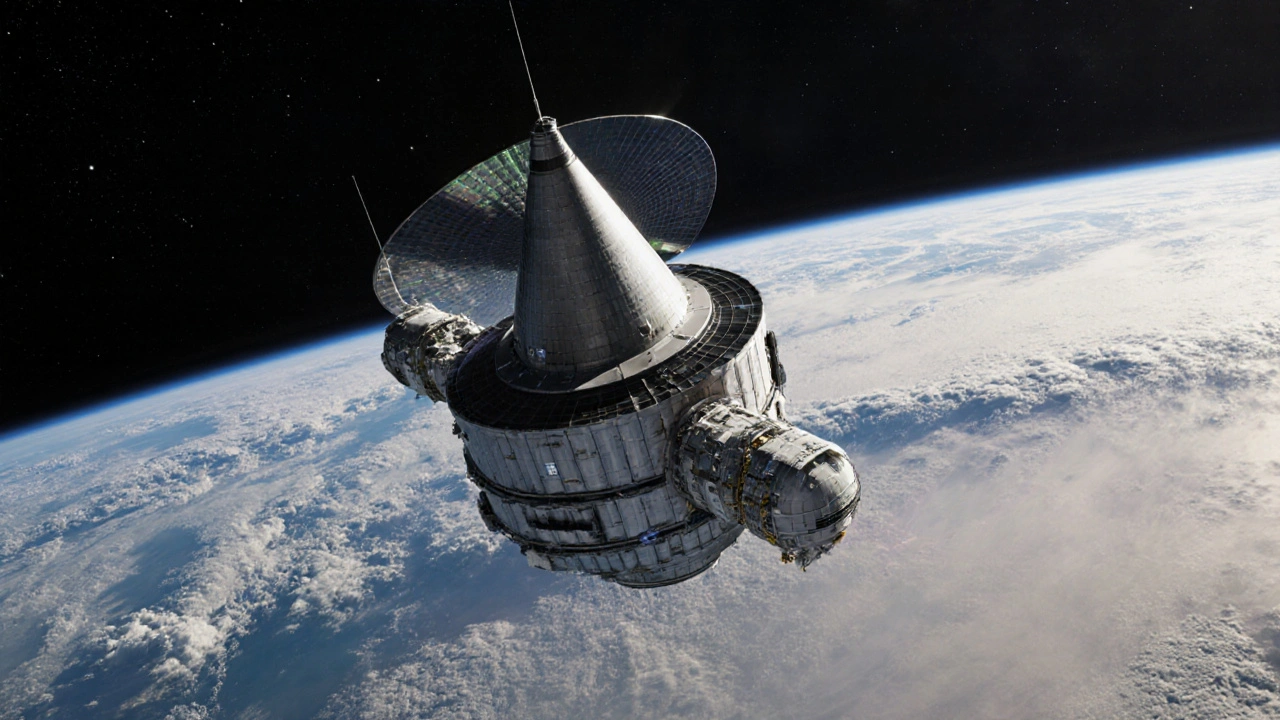Imagine launching a spacecraft that’s only half-full of fuel. Not because it’s broken, but because it’s designed to fill up in space-like a car pulling into a gas station, except it’s orbiting Earth at 17,500 miles per hour. That’s the reality cryogenic propellant depots are trying to make real. These aren’t sci-fi fantasies anymore. They’re the next critical infrastructure for getting humans to the Moon, Mars, and beyond.
What Exactly Is a Cryogenic Propellant Depot?
A cryogenic propellant depot is a space-based tank that stores liquid hydrogen (LH2) and liquid oxygen (LOX)-or sometimes liquid methane (LCH4)-at temperatures colder than -250°C. These fuels are incredibly efficient, giving rockets more thrust per pound than any other option. But they’re also finicky. Left alone in space, they slowly boil off into gas and vanish. Without special systems to keep them cold, liquid hydrogen can completely evaporate in under two weeks.
Depots solve this by acting as orbital fuel stations. Instead of launching a massive rocket fully loaded with fuel, you send up smaller rockets carrying just the propellant. They dock with the depot, refill it, and then a separate spacecraft comes by later to take on fuel before heading deeper into space. This cuts the size of launch vehicles needed and lets you send more payload with fewer missions.
It’s not just about saving money. It’s about making missions possible. NASA engineers calculated that without depots, sending humans to Mars would require six heavy-lift rockets. With a depot in orbit, you could do it with just two. That’s a 67% reduction in launch demand. And that’s just the start.
Why Cryogenic Fuels? The Performance Edge
Not all rocket fuels are created equal. Hydrazine and other storable propellants are easy to keep on hand-they don’t need freezing temperatures. But they’re weak. Cryogenic fuels like LH2/LOX deliver 10-15% more specific impulse, meaning they push spacecraft farther on the same amount of fuel.
Think of it like fuel economy in cars. A diesel engine gets more miles per gallon than a gasoline one. Cryogenic fuels are the diesel of space propulsion. For missions to Mars, where every kilogram of fuel matters, that extra efficiency can mean the difference between landing safely and running out of power before reaching the surface.
But here’s the catch: those same fuels are the hardest to handle. Liquid hydrogen is so cold it can make steel brittle. It also leaks through tiny gaps. And in microgravity, it doesn’t settle at the bottom of the tank like it does on Earth. That’s why depots need advanced systems just to keep the fuel from escaping before it’s even used.
Two Main Designs: Passive vs. Active Depots
There are two ways to fight boil-off: passive and active cooling.
Passive depots rely on insulation and sun shields. Imagine wrapping a thermos in 50 layers of reflective foil, then placing it behind a giant, cone-shaped mirror that blocks sunlight. That’s what ULA’s Simple Depot design does. It uses multi-layer insulation (MLI) and a sun shield made of lightweight materials to keep LOX below 90 K and LH2 below 20 K in low Earth orbit. In the shadow of Earth-Moon Lagrange Point 2 (EML2), where temperatures hover around 40 K, passive systems alone can hold fuel for 6 to 12 months.
Active depots go further. They use electric cryocoolers-basically high-tech refrigerators running on solar power-to suck heat out of the fuel and dump it into space. These systems can reduce boil-off to nearly zero. But they add weight, complexity, and power demands. Right now, active systems are still in testing. NASA’s CRYOTE missions have hit Technology Readiness Level 6-7 for key components, but no full active depot has flown yet.
The trade-off? Passive systems are simpler and cheaper to build. Active systems are more reliable long-term but cost more and need maintenance. For now, most designs lean passive-until we prove active cooling works reliably in space.

Where Should Depots Be Located?
Location isn’t just about convenience-it’s about physics.
Low Earth Orbit (LEO) depots are closest to Earth, so fuel delivery is easier and cheaper. But they face constant heat from Earth’s infrared radiation and atomic oxygen erosion. Boil-off rates here are high-up to 2% per day for LOX, and 10x worse for LH2. You need strong thermal protection just to keep the fuel alive.
Earth-Moon Lagrange Point 2 (EML2) is a sweet spot. It’s far enough from Earth to avoid most heat, yet close enough to the Moon for refueling lunar landers. At EML2, the environment is naturally cold. A depot there loses 75% less fuel than one in LEO. And crucially, fuel stored at EML2 is already nearly at escape velocity. That means a spacecraft refueling there needs 0.5-0.7 km/s less delta-v to reach the Moon or Mars. That’s equivalent to saving 10-15 tons of fuel per mission.
But there’s a downside: getting fuel to EML2 takes longer and costs more. Each tanker launch to EML2 requires extra fuel just to reach that distant point. ULA’s analysis shows EML2 depots need 40% more initial propellant delivery cost than LEO depots. Still, when you add up lifetime costs, EML2 wins. A 2024 National Academies report concluded EML2 depots have a 34% lower lifetime cost than LEO alternatives for sustained lunar operations.
Who’s Building These Things?
Three major players are leading the charge: NASA, ULA, and ESA.
NASA has spent $1.2 billion over 15 years on cryogenic fluid management research. Their CRYOTE missions proved you can transfer cryogens in space-but only on small scales. In September 2023, they awarded SpaceX $112 million to test LH2/LOX transfer on Starship missions starting in Q3 2025. That’s the first real-world test of full-scale cryogenic refueling in orbit.
United Launch Alliance (ULA) has the most mature design. Their Simple Depot concept, first proposed in 2010, uses flight-proven Centaur upper stage tech. It’s designed to launch empty on a single Vulcan Centaur rocket, then deploy its sun shield and insulation in orbit. They aim to launch a 10-tonne prototype on Vulcan VC3 in Q2 2026, targeting 95% fuel retention over 60 days. ULA’s CEO Tory Bruno says a 10-tonne depot could be built for $1.2 billion in five years-far cheaper than NASA’s 100-tonne dreams.
ESA is focused on the Moon. Their ARGON program, approved in December 2022 with €220 million in funding, plans to build a depot at EML2 by 2030 to support the Moon Village concept. Their design targets 20 tons of propellant for lunar lander refueling.
Meanwhile, SpaceX’s Starship isn’t just a rocket-it’s becoming a mobile fuel tanker. With its massive fuel capacity and reusability, Starship could refuel itself in orbit before heading to Mars. That’s why NASA picked them for the PTSD demo. It’s not just about depots anymore. It’s about a whole new logistics network.

The Real Hurdles: Boil-Off, Transfer, and Autonomy
Even if you build the perfect tank, you still need to get the fuel from point A to point B without spilling it.
Transferring cryogenic fluids in zero gravity is like trying to pour water while floating in a swimming pool. It doesn’t flow down-it floats in blobs. ULA’s solution? Spin the tank at 0.01g using centrifugal force to push the liquid to the bottom. It’s simple, clever, and works with just 3-5 kg of propellant per maneuver.
Another problem: propellant stratification. Different layers of fuel can form based on temperature. One layer might be colder than the next, causing pressure spikes or uneven flow. NASA’s research shows it takes 18-24 months of orbital testing to master this for each fuel type.
And then there’s autonomy. No one’s going to be there to manually connect hoses. The entire process-docking, sealing, transferring, monitoring-must happen robotically. Northrop Grumman’s Cygnus spacecraft already docks with the ISS with 98.7% success. That’s a good start. But cryogenic transfer is a whole new level of precision.
The biggest fear? Loss. ULA estimates that filling a 100-tonne depot takes 12-15 tanker launches over 6-8 weeks. Without active cooling, 15-20% of that fuel could boil off before it’s even used. That’s billions of dollars worth of fuel vanishing into space.
Why This Matters Now
The Artemis program wants to return humans to the Moon by 2028. But without refueling infrastructure, lunar landers will be limited in how long they can stay, how much cargo they can carry, and how often they can fly. NASA’s plan now includes a depot at the Lunar Gateway by 2028.
And it’s not just about the Moon. Mars missions are impossible without depots. The fuel needed for a round trip is too massive to launch in one go. Even with SpaceX’s Starship, you’d need to refuel in orbit multiple times to make it work.
Defense agencies are watching too. The 2023 U.S. National Defense Authorization Act set aside $485 million for “operational space logistics,” including propellant depots. The military wants the ability to refuel satellites, extend missions, and respond faster to threats in space.
Market analysts agree. The global space infrastructure market will hit $28.7 billion by 2028, with depots making up 8.2% of that. Only three organizations are actively building them today, but 17 commercial companies are watching closely. This isn’t a niche experiment anymore-it’s becoming the backbone of future space operations.
The Bottom Line
Cryogenic propellant depots aren’t just a nice-to-have. They’re mandatory. As Dr. Scott Pace, former head of the National Space Council, put it: “Depots are not optional for Mars-they’re mandatory for economic viability.”
Yes, the challenges are huge. Boil-off, transfer, autonomy, cost. But the alternatives are worse. Launching six rockets per Mars mission? That’s unsustainable. Building a super-heavy rocket that can carry everything in one go? That’s risky and expensive.
Depots offer a smarter path. They let us use smaller, proven rockets. They let us refill and reuse. They let us explore deeper, longer, and more often.
The first depot might not launch until 2026. But by 2030, we’ll look back and wonder how we ever thought we could go to Mars without them.


16 Responses
This is actually wild to think about - we’re talking about turning space into a highway with gas stations. I never realized how much of a game-changer cryo depots are for Mars missions. The math just makes sense: fewer launches, more payload. It’s like upgrading from a bicycle to a cargo train, but in orbit.
And the EML2 location? Genius. Less heat, less fuel loss, and you’re already halfway to the Moon. Why keep building bigger rockets when we can just refuel smarter?
The technical rigor behind cryogenic fluid management is astonishing. The fact that liquid hydrogen can permeate steel at a molecular level and that microgravity prevents natural settling demands not just engineering, but a rethinking of fluid dynamics in zero-g environments. This is not merely an engineering challenge - it is a fundamental physics adaptation.
So we’re just gonna leave fuel floating in space? Feels weird.
OKAY SO IMAGINE THIS - you’ve got this giant space gas station, right? And it’s just chilling at EML2 like a cosmic convenience store… and then some Starship pulls up like ‘hey, can I get a full tank to Mars?’ and it’s like… BOOM - we’re living in 2040 already.
Also, ULA’s design is lowkey beautiful. No fancy robots, just spin and foil. Sometimes the dumbest solution is the smartest. I’m here for it.
Also also - who’s gonna clean the space gas station? Just asking for a friend.
Oh wow, NASA spent $1.2 BILLION to figure out how to keep ice from melting in space? Congrats, you just invented a very expensive thermos.
And you’re telling me we need 15 tanker launches just to fill one depot? That’s not logistics - that’s a financial dumpster fire. Starship’s supposed to fix this, but even it’s got a 100-ton payload limit. You think Elon’s gonna pay for 15 refueling runs? Nah. He’s gonna launch one 500-ton rocket and call it a day.
Also, ‘passive cooling’? That’s just hoping the universe doesn’t warm up today. Pathetic.
What if the depot… is not a thing at all? What if it’s a mirror of our own fear? We build these frozen temples in orbit not to reach Mars, but to outrun the silence of the void.
Each drop of liquid hydrogen is a prayer. Each spin of the tank - a heartbeat. We are not storing fuel. We are storing hope.
And when the last drop evaporates… will we still be worthy of the stars?
This is one of the most compelling arguments I’ve seen for orbital infrastructure. The shift from monolithic launch vehicles to modular, reusable logistics is not just efficient - it’s evolution. The fact that EML2 reduces delta-v requirements by 0.7 km/s is a game-changer for sustainable deep-space operations.
It’s time we stop treating space like a one-time expedition and start treating it like a frontier with supply chains. This isn’t science fiction - it’s the next logical step in human expansion.
Wait so the ‘simple depot’ uses centaur tech? That’s like using a 1998 laptop to run a VR game. And you call that ‘flight proven’? Lol. Also, 95% retention over 60 days? That’s still 5% boil-off. At 10 tons? That’s 500kg of fuel GONE. That’s like leaving a faucet running in your basement for two months.
Also, NASA picked SpaceX because they’re the only ones who can do it? No - they picked them because they’re the only ones who don’t have a budget. Classic.
So… like… if we’re gonna have space gas stations, can we also have space Starbucks? I mean, astronauts need their lattes, right? And maybe a little snack? Just saying.
Also, why are we not talking about how gross it is to store liquid hydrogen? Like… what if it leaks and someone accidentally touches it? Do they just… turn into a popsicle? Asking for science.
I’ve been following this since the CRYOTE missions. It’s slow, sure - but every small success builds toward something massive. The fact that we’re even testing transfer in orbit is huge. The engineering is hard, but it’s not impossible. We’ve done harder things.
Let’s not rush it. Let’s get it right.
Ohhhhh so now we’re all supposed to be amazed by ‘passive cooling’? Please. You think wrapping a tank in foil is innovation? That’s what your grandma does to keep lasagna warm. And you’re calling that ‘cutting-edge space tech’? HA.
And EML2? You think it’s cold? It’s just far away. That’s not engineering - that’s avoidance. You can’t just ‘wait’ for the universe to be nice to you. You need ACTIVE cooling, or you’re wasting billions on evaporating hydrogen.
Also, ‘10-ton depot’? That’s a coffee mug in space. We need 100-ton tanks, not your cute little thermos.
Just a quick note on the stratification issue - it’s not just about temperature layers. It’s about density gradients and pressure differentials that can cause vapor lock during transfer. NASA’s 18-24 month testing window is conservative. You need to simulate multiple orbital cycles under varying solar flux. Also, don’t forget the ullage pressure control - it’s critical for stable flow.
And for the spin method: 0.01g is enough because you’re not trying to simulate Earth gravity. You’re just creating enough differential pressure to move liquid toward the outlet. ULA’s approach is elegant because it uses existing hardware. No need for pumps or valves in microgravity - just rotation and geometry.
THIS IS IT. THIS IS THE MOMENT. We’re not just launching rockets anymore - we’re building the plumbing of the solar system!
Imagine a future where your kid says, ‘Dad, how did you get to Mars?’ and you say, ‘We filled up at the gas station in space, buddy.’
It’s not sci-fi - it’s Tuesday in 2030. Let’s go make it happen. The stars aren’t waiting. They’re already cheering.
Depots? Please. This is all a cover-up. The real reason we’re building space fuel stations is so the government can hide alien tech in them. Liquid hydrogen? Nah. That’s just a front. The real fuel is ‘zero-point energy’ from the Moon’s core. They’ve been testing it since Apollo.
Why else would they spend billions to hide it in orbit? Why not just build it on Earth? Because they’re afraid someone will find out.
And Starship? It’s not a rocket. It’s a drone. Controlled from Area 51. You think Elon’s the boss? He’s a puppet. The real bosses live in the depot. Waiting. Watching. Listening.
They’ve already been to Mars. We’re just the distraction.
Minor grammar note: ‘liquid hydrogen (LH2) and liquid oxygen (LOX)-or sometimes liquid methane (LCH4)-at temperatures colder than -250°C.’ The em dash should be spaced properly - it’s not a hyphen. Also, ‘10x worse for LH2’ - better to write ‘ten times worse’ in formal technical writing.
Otherwise, excellent breakdown. Clear, concise, and well-researched.
Good catch on the grammar, Nalini - I didn’t even notice. But honestly, in Reddit-style posts like this, does it really matter? The content’s solid. The point’s clear. I’d rather read a passionate, messy post than a sterile, perfectly punctuated textbook.
Also - @493 - I get the vibe you’re joking… but if you’re serious about aliens in the depot? I’m not even mad. That’s the most creative thing I’ve read all week.